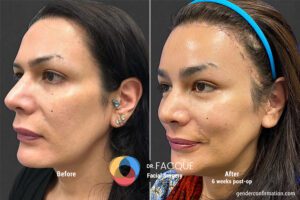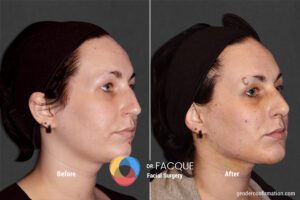Gender-Affirming Rhinoplasty: Understanding Rhinoplasty for Transitioning Patients
Medically reviewed by Jennifer Richman on February 07, 2024.
Introduction: MTF Rhinoplasty and other Techniques
More commonly known as a nose-job, a facial feminization surgery (FFS) rhinoplasty is a surgical procedure that permanently alters the internal structure and/or external appearance of the nose. In cosmetic plastic surgery, rhinoplasty is used to change the dimensions of the nostrils, the configuration of tip of the nose and/or the contour of the nose bridge to achieve a more symmetrical or balanced appearance. For reconstructive purposes, a rhinoplasty can improve respiratory functions, repair the nose contour after trauma or address developmental concerns.
In gender-affirming care, a “male-to-female” (MTF) rhinoplasty is designed to relieve our patients of gender dysphoria and ensure their facial contour reflects their gender identity. We recognize that the term “MTF” is an outdated way to name procedures that help trans women and feminine-spectrum non-binary folks experience greater gender congruence. Still, we use it out of the recognition that many of our patients search these terms to find helpful information about surgical transition.
This article focuses on the surgical techniques, costs, possible complications, and recovery instructions associated with rhinoplasty. If you are interested in undergoing gender-affirming facial surgery, you can request a free surgical consultation with Dr. Ley (she/her/they) or Dr. Facque (he/him) at the GCC (Gender Confirmation Center).
Rhinoplasty Before & After
Below is an example of a rhinoplasty that was a part of one of Dr. Facque’s FFS procedures:
Below is an example of a rhinoplasty that was a part of one of Dr. Facque’s facial masculinization surgery procedures:
What is MTF Rhinoplasty?
“MTF” Rhinoplasty is an antiquated term for a rhinoplasty or nose reconstruction surgery that forms part of someone’s facial feminization surgery (FFS). FFS refers to a host of surgical procedures that patients can choose from to bring their facial features in greater alignment with their gender. Just as there is no universal formula for undergoing FFS, there is no one correct way to “feminize” a nose or perform a MTF rhinoplasty. Depending on a patient’s unique goals, your surgeon can perform any of the following:
- Nose tip: In many people who undergo a first, testosterone-dominant puberty, develop a downward-turned nose tip. Many patients request that their nose tip be altered to give it a slightly upward tilt.
- Nose bridge: Some, not all patients, are unsatisfied with the shape of the bridge (aka., dorsal ridge) of their nose. In some populations, a testosterone-dominant puberty results in the widening of the nose bridge. Reducing its size and/or straightening out the structure is what some patients request.
- Nostrils: If a patient would like to alter the dimensions of their nostrils, this can be addressed in surgery.
- Structural concerns: If a patient has respiratory issues due to the structure of the nose fossa or a deviated septum, your surgeon may be able to fix these issues during your FFS rhinoplasty.
Rhinoplasty for trans feminine and transgender women can reshape the nasal features to create a more feminine appearance. Facial characteristics of the nose that are considered to be masculine, such as a broader brow ridge or more prominence, can be adjusted. Wide nostrils, wide/rounded nasal tip, and a more pronounced dorsal ridge are targeted. Attention to the dorsal ridge, or raising the tip of the nose, and reshaping and resizing the nostrils can create a more feminine appearance for our patients who are trans feminine and transgender women.
Why MTF Rhinoplasty is Important in Gender-Affirming Care
MTF rhinoplasty comes with a wide set of emotional and physical benefits. For our patients, Rhinoplasty and other FFS procedures can be essential to relieve gender dysphoria for our patients. Reports of improved self-esteem, deep satisfaction and gender euphoria are common amongst our patients and reports from peer-reviewed studies.
Classically, the purpose of an FFS rhinoplasty is to reverse the effects a first, testosterone-dominant puberty had on the patient’s nasal cartilage development. In some cases, testosterone creates a more pronounced dorsal ridge and lowers the tip of the nose; re-constructing the nose to reverse these developments is a common, but not universal strategy in gender-affirming facial surgery. That said, not everyone who is assigned male at birth experiences these changes in puberty. More important, these are not universal guidelines around what is and is not a feminine nose.
Who is a Good Candidate for MTF Rhinoplasty?
At the GCC (Gender Confirmation Center), both Dr. Ley (she/her/they) and Dr. Facque (he/him) use informed consent standards to determine patient eligibility for facial surgery. In practice, this means that adult patients can make the decision to undergo surgery once they have been educated on the advantages and risks involved in the procedures.
Your overall physical health, which includes your medical history, are important for our surgeons to keep into account. For example, patients who are smokers often experience delays in wound healing. For questions about how we can minimize your risk of surgical complications, you can speak to a surgeon in a free consultation.
Due to health and safety issues, you may not be a good candidate for surgery if you have any of the following conditions. Taking some time to optimize your medical conditions before pursuing facial surgery can allow you to qualify for FFS:
- Heavy smoker, drinker, or drug user
- Uncontrolled diabetes
- Uncontrolled high blood pressure
- Bleeding or clotting disorders
- Significant lung or heart disease
- Active sinus infections
- Previous facial trauma, sinus surgeries, etc.
- Current or recent use of intranasal drugs
Surgical Techniques in MTF Rhinoplasty
Rhinoplasty is divided into two major types: open and closed rhinoplasty. Each has its own benefits and complications. Our surgeons will work with you to decide which surgical technique is best for you.
Between the two, the key difference depends on how the incision is performed.
- The open rhinoplasty is performed through an incision in the nostrils or across the columella, the narrow strip of tissue that separates the nostrils, where the skin can be folded up to see the underlying structure. Unlike other FFS procedures that leave external scars, this scar heals to be nearly invisible. The incision typically fades relatively quickly, however, it is important to consider a patient’s history with scarring as hyperpigmentation and hypertrophic scars are still possible.
- A closed rhinoplasty does not include this external incision or any external scarring that occurs afterward because the incisions are hidden inside the nose. The surgery is done through the nostrils. Because of this approach, surgeons may be limited in the amount of surgical changes that can be done. This procedure is less common in FFS.
Can I get a rhinoplasty if I have nose piercings?
If you have piercings on your face, you should let your surgeon know prior to surgery. For example, in some cases it is possible that having a septum piercing means that your nasal cartilage is damaged; therefore, you may not be an ideal candidate for a rhinoplasty. In the informational video below, Dr. Facque (he/him) explains how piercings play a role into planning surgery and when patients can get facial piercings post-op:
What to Expect During Recovery
When it comes to rhinoplasty recovery, most patients’ concerns have to do with when they will be able to see their final results. Generally speaking, after the first few weeks of recovery, most of your swelling will resolve. However, throughout the first year post-op, swelling will fluctuate day-to-day. It can be difficult to be patient with yourself as your body heals; we encourage our patients to practice self-compassion as they wait 12 months to see their final results.
Otherwise, you can expect the following during the different stages of healing:
1-week Post-Op:
Following the immediate post-op period, your under eye area may incur a lot of swelling and bruising. Splints inside the nose as well as dried nasal secretions may temporarily make it feel more obstructed to breathe through the nose. During your first post-operative appointment, about one week after surgery, your surgeon will remove nasal sutures and splints.
3-6 weeks Post-Op:
At this point in time, there are activity restrictions recommended. For the first three weeks patients may need to refrain from vigorous activity such as cardio exercise and weight training. However at the 6 week mark, patients can resume full activity. We ask that patients refrain from placing any pressure directly on the nose – such as ice packs, glasses or sunglasses for at least 6 weeks.
3-12 months Post-Op:
Patients should anticipate some degree of swelling for 3-6 months. Following the 6 month period, swelling should reside and appear minor. The nose will continue to take its final shape as the cartilage heals into its new position and as the skin of the nose shrinks over its new form. The final result of rhinoplasty is visible around one year after surgery, but published research notes that the appearance of the nose after rhinoplasty may continue to shift over the course of 5-10 years after surgery, depending on the techniques used.
Risks and Potential Complications
Risks and potential complications accompany any surgical procedure. However, working with an experienced, board-certified surgeon can mitigate the potential for risks and complications. Both Dr. Ley (she/her/they) and Dr. Facque (he/him) have extensive training in craniofacial surgery and experience working with trans and non-binary folks to achieve their unique goals.
Scarring, bleeding, and skin discoloration are the most common complications to occur after rhinoplasty. These are not a serious concern as they are a normal part of the healing process. Minor bleeding is expected after surgery, but excessive bleeding may be cause for concern. If bleeding does not stop after 10 minutes of pressure on the site, please go to an emergency room.
Infections can occur around the incision site or within the nasal cavity but with proper care can be avoided.
Cost of MTF Rhinoplasty
A surgeon’s experience and credentials can affect the cost of rhinoplasty for our patients. However, obtaining insurance coverage for FFS can substantially reduce your share of the cost. At the GCC, our Insurance Concierge Team has a 90% success rate in securing coverage for interested patients.
At the GCC, patients without insurance coverage have paid between $6,000-$18,000 for a rhinoplasty and-or cheek augmentation. These estimates do not include facility or anesthesiology fees. Since every rhinoplasty is different, based on a patient’s unique goals, we are not able to give exact quotes for this procedure until after your free, virtual or in-person consultation, which you can request here.
How to Choose the Right Surgeon for MTF Rhinoplasty
If you are undergoing any FFS procedure, it is essential that your surgeon be board-certified and have hospital privileges. Maintaining board certification, continued education and practice, as well as maintaining an inventory of before and after photos and patient reviews help our patients determine the expertise and credibility of our surgeons.
Ensuring your surgeon has adequate background and experience to perform gender-affirming surgery is a key part of your surgical process. Schedule a free, in-person or virtual consultation here to learn more about our surgeons and to develop your surgical plan.
Conclusion
Adjusting the nose contour through rhinoplasty can be incredibly useful for transgender women and trans feminine non-binary people. At the GCC, our surgeons are expertly qualified to provide you the best possible care. To get started, schedule a free in-person or virtual consultation today.
Request a Free Surgical Consultation Today.
All virtual and in-person consultations with our board-certified surgeons are free. Once you fill out this form, our patient care team will reach out and guide you through every step to get to surgery.







